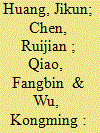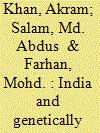| Srl | Item |
| 1 |
ID:
143434


|
|
|
|
|
| Summary/Abstract |
As the rapid development of Genetically Modified crops, Chinese government has been increasing its efforts in GM crop biosafety management. However, the rapid expansion of Bacillus thuringiensis (Bt) cotton varieties and less regulated seed industry also resulted in a large amount of Bt cotton varieties that bypassed China's biosafety regulations. This study shows that the Bt cotton varieties without biosafety certificates (BC) have been widely used by farmers in practice. Econometric analysis further shows that the Bt cotton varieties with BC outperform the varieties without BC in terms of pesticide use. The paper concludes with policy implications.
|
|
|
|
|
|
|
|
|
|
|
|
|
|
|
|
| 2 |
ID:
140129


|
|
|
|
|
| Summary/Abstract |
Given the high level of poverty, malnutrition and hunger and the low level of agricultural productivity in India, agricultural biotechnology has great potential. To feed a billion-plus population by relying on conventional methods of cultivation is next to impossible. India is rich in bio-resources and biotechnology offers opportunities for converting biological wealth into economic wealth, thereby creating new employment opportunities on an environmentally and socially sustainable basis. Biotech crops have been cultivated globally for the past two decades with no negative impact on human beings, animals and the environment. The success of Bt cotton in India in the 2000s has set an excellent example of how genetically modified (GM) technology can turn around India’s agriculture sector. Safety of GM crops being a serious issue, it is important to ensure that India has adequate regulatory instruments and infrastructures. At the same time, India has more serious food safety risks to worry about including unsanitary food processing, as well as food security concerns pertaining to the availability and affordability of food. Priority must go to more clearly demonstrated safety risks instead of hypothetical risks.
|
|
|
|
|
|
|
|
|
|
|
|
|
|
|
|
| 3 |
ID:
105130


|
|
|
|
|
| Publication |
2011.
|
| Summary/Abstract |
Rapid developments of technological tools in the development of transgenic cotton harbouring the Bacillus thuringiensis (Bt) gene for conferring resistance to bollworm have played a major role in ushering an agri-biotechnology revolution at the global level and more so in Southeast Asian countries like India and China. The unprecedented increase in the use of these technologies and major investments by technology providers through strategic alliances or through agreements has brought the tools into a developing country like India. The objective of the present study is to assess patenting trends of this revolutionary technology in agriculture and its role in commercialization of the crop. Patent landscape analysis was deployed to map bibliographic patterns such as publication and priority year, country, assignees and technological analysis of major research areas with applications in technology development. The study illustrates the crowded domain of technology providers and the need to build strategic partnership platforms for effective use of the products.
|
|
|
|
|
|
|
|
|
|
|
|
|
|
|
|